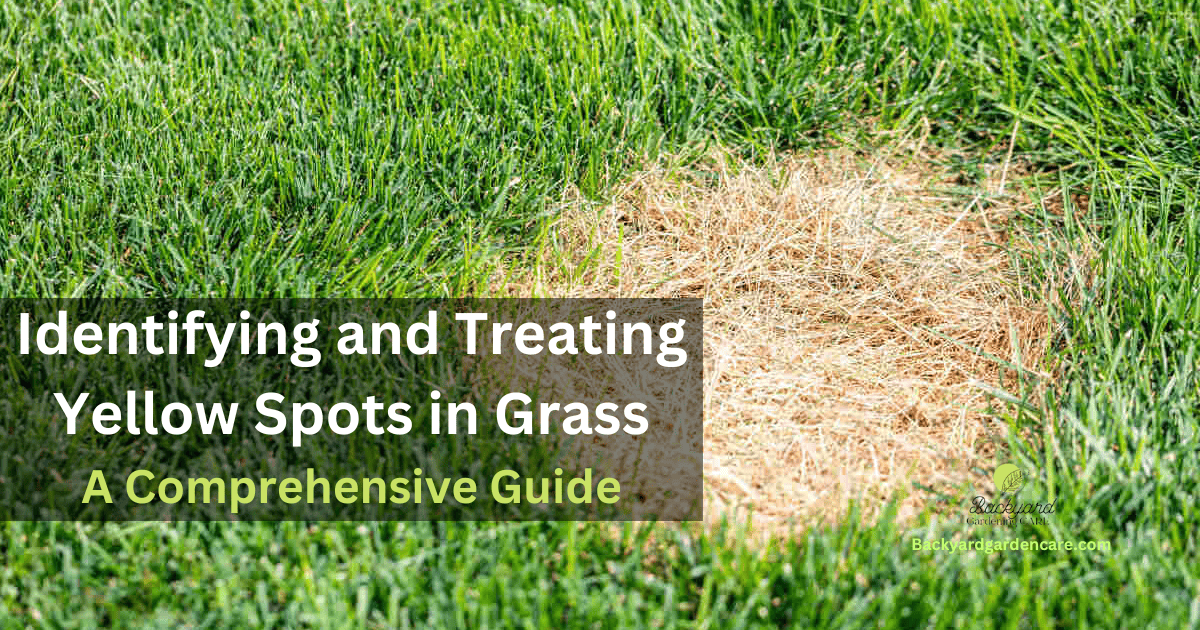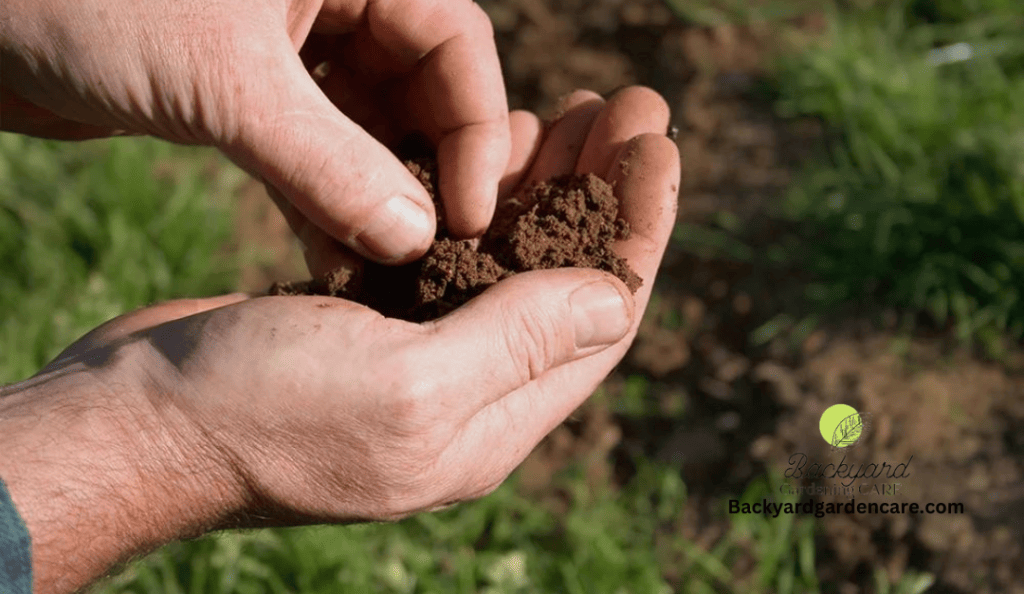Yellow Spots in Grass Identifying and Treating: 6 Sure Reasons A Comprehensive Guide
Maintaining a lush and healthy lawn can be challenging, especially when unsightly yellow spots appear. Various factors, including nutrient deficiencies, pet urine, or disease, can cause these yellow spots.
If left untreated, these spots can spread and ruin the overall appearance of your lawn. That’s why it’s important to understand the causes of yellow spots and how to treat them effectively.
In this article, we will explore different methods and techniques for treating yellow spots in grass so that you can restore your lawn to its vibrant green state.
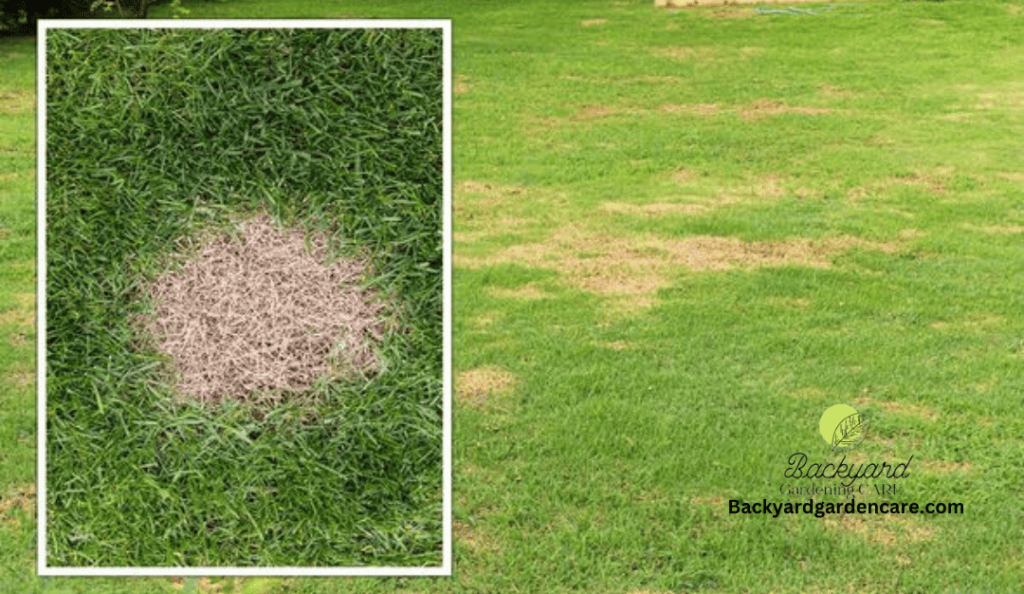
Let’s get started.
Understanding Yellow Spots in Grass
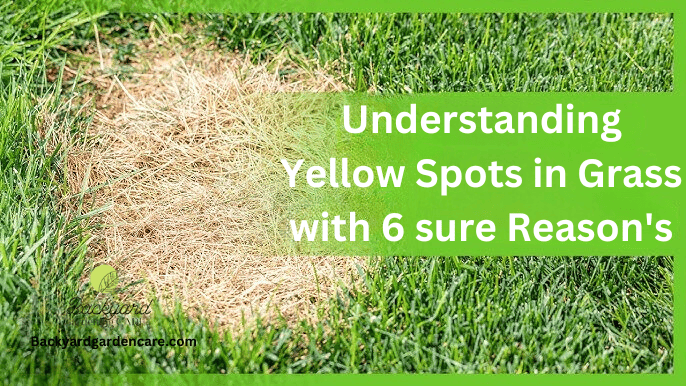
You’re not alone if you’ve ever noticed unsightly yellow spots on your lush green lawn. Yellow spots in the grass can be a frustrating sight for any homeowner.
But fear not, for in this section, we will delve into the causes of these yellow spots and provide you with a better understanding of how to prevent and treat them.
Seasonal Changes
Seasonal changes can have a major impact on the appearance of your lawn, often leading to yellowing and discoloration. One common mistake that homeowners make is lawn scalping, which refers to cutting the grass too short with a lawnmower.

This practice can leave behind only yellow or brown grass, giving your lawn an unhealthy and unappealing look. It’s important to remember that a low mow should only occur during the first cut of spring, as cutting the grass too short later in the season can cause more harm than good.
There is also the possibility of some grass suffering from diseases in the spring since temperatures are constantly changing. These fluctuations create an environment conducive to disease development, leading to yellowing and other issues.
It is important to monitor the temperature changes and take appropriate action to prevent or treat any diseases that may arise. Additionally, iron deficiency can also contribute to the yellowing of your lawn.
During heavy rainfall, the turf may grow faster than it can absorb nutrients, leading to grass yellowing. This nutrient imbalance can be addressed by providing your lawn with the necessary iron supplements.
As we transition into fall and winter, Bermuda grass, a warm-season grass, can turn especially yellow. This is a natural response to the cooling temperatures and shorter days.
However, it’s essential to understand that this yellowing is a temporary occurrence and not necessarily an indication of a problem with your lawn. Bermuda grass will typically regain its vibrant green once warmer seasons return.
To combat the seasonal challenges and maintain a healthy, green lawn, there are a few solutions you can consider. Firstly, avoiding cutting more than one-third of the grass blade is crucial, especially after the year’s first cut.
This practice allows your lawn to maintain its health and vigor throughout the different seasons. Additionally, it’s helpful to know the proper mow heights for your grass type and the corresponding season.
If your lawn experiences dormancy-induced yellowing, you may consider over-seeding with another grass type.
This technique can help fill in bare spots and provide a green appearance while your primary grass type goes through its dormant phase. Alternatively, you can wait until spring to repair your lawn, as the grass will naturally return to its growth-season green.
Solving Soil Problems.
Sometimes, yellow spots in grass can indicate underlying soil issues. Poor soil quality, compacted soil, or nutrient deficiencies can all contribute to yellowing grass. The soil’s lack of essential nutrients can make an unhealthy lawn susceptible to pests and diseases.
These issues can cause the grass blades to turn yellow, indicating a problem that needs to be addressed. One common issue that arises in the spring is a nitrogen deficiency in the soil. This deficiency can hinder the growth and overall health of your lawn.
One effective solution for soil issues that cause a yellow lawn is to amend the soil with compost. Compost is a natural and organic material that can help address problems such as poor drainage and improper pH levels.
Adding compost to the soil can improve its structure, water-holding capacity, and overall health. Compost also provides essential nutrients that promote healthy growth and resilience in your lawn.
Addressing soil issues with compost is a relatively simple process. Begin by spreading a layer of compost evenly over the affected areas of your lawn. Use a rake or garden fork to work the compost into the soil, ensuring it is well-incorporated.
This will help improve the soil’s quality and provide a favorable environment for the grass to thrive. It is important to consider other factors that may be contributing to soil issues, along with amending the soil with compost.
For instance, improper watering practices can lead to poor soil conditions. You can restore its health and vibrancy by addressing soil issues and providing the necessary nutrients and conditions for your lawn to thrive.
Consider conducting a soil test to determine your soil’s pH level and nutrient content. Based on the results, you can amend the soil accordingly to promote healthy grass growth.
The Water Supply is Insufficient.
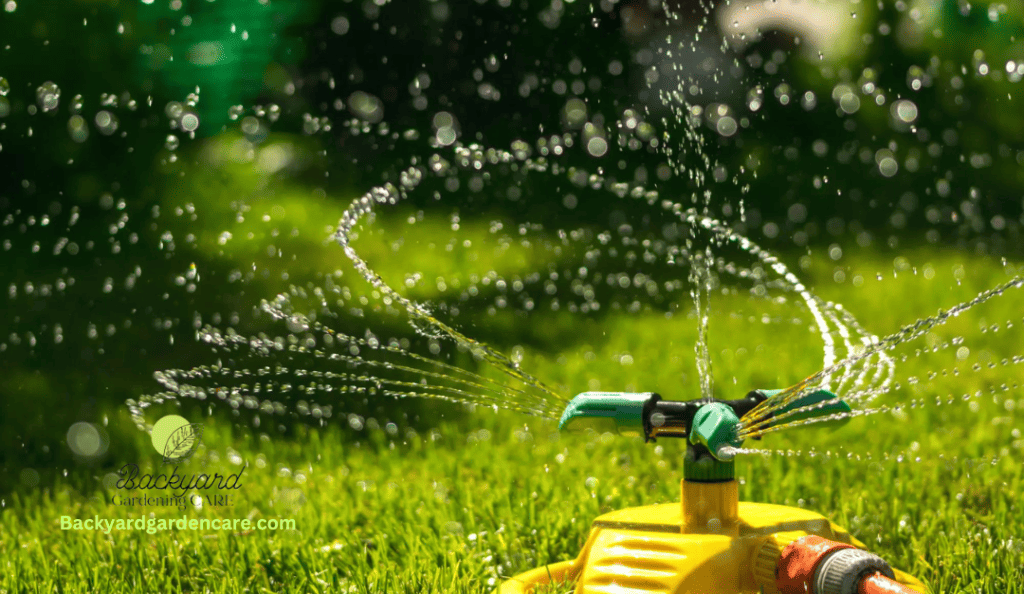
The most common cause of yellow patches on lawns is an irrigation problem, which can be easily fixed. It is important to consider your soil type before ruling out this cause.
If you have light or sandy soil, it doesn’t matter how much rain your garden receives; it won’t be able to hold onto water. It could result from a drought period or your soil’s difficulty retaining moisture.
If you notice yellow patches on your lawn, it is likely due to insufficient watering. To confirm this, check the soil below the surface. If the earth is dry down to 10cm, it clearly indicates that more water is needed.
The best way to improve water retention in sandy soil is to combine well-rotted organic matter, such as compost or manure, in the soil to improve its water retention. This will help the soil retain moisture and prevent yellow patches from forming on your lawn.
Overwatered.
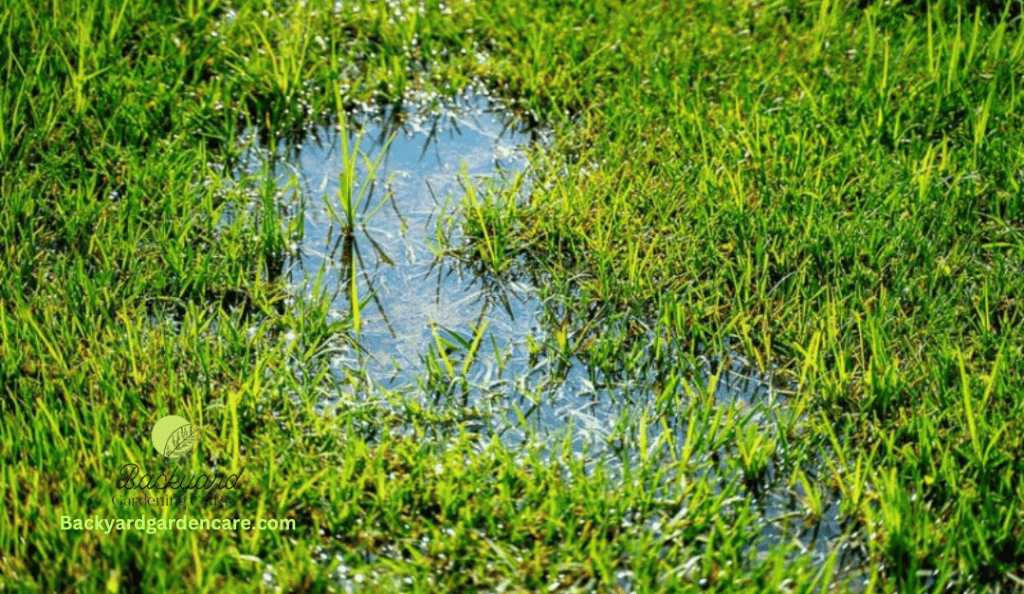
Sandy soil is generally not affected by excessive water, but heavy clay soil can lead to yellowing turf due to water saturation. In order for turf to remain healthy, it requires a balance of sunlight, water, and oxygen. However, when soil becomes waterlogged, the roots of the grass plants are deprived of oxygen.
If you have heavy clay soil that retains water, it is important to regularly aerate the soil to facilitate oxygen flow to the roots and improve drainage. The easiest and most efficient way to achieve this is by using an aerator tool.
It is also important to regularly monitor the moisture levels in your soil. While you cannot control the weather, you can take steps to manage your soil’s drainage. A simple way to check moisture levels is by making a small hole in the ground and inserting your finger.
If the soil is waterlogged up to a depth of about 3-4cm, it is a clear indication that aeration is needed to improve the condition of the soil. By proactively managing your soil’s drainage, you can ensure your turf remains healthy and vibrant.
Regularly aerating your soil and monitoring moisture levels are important steps in preventing the negative effects of waterlogged soil. Remember, healthy grass plants require a balance of sunlight, water, and oxygen.
Dog Urine.

Yellow spots in the grass are a common problem for many homeowners, and one of the main causes of these unsightly patches is dog urine. When dogs relieve themselves on the lawn, their urine contains a lot of nitrogen.
While nitrogen is an essential nutrient for plants, an excess of it can actually burn the grass and lead to yellow spots. One effective way to minimize the damage caused by dog urine is to water the area immediately after your dog urinates.
Doing so can dilute the nitrogen in the urine and prevent it from burning the grass. This simple step can go a long way in preserving the health and appearance of your lawn.
To implement this strategy, keeping a close eye on your dog when they go outside to relieve themselves is important. As soon as they finish, grab a hose or watering can and give the area a good soak.
This will help flush the excess nitrogen and prevent it from lingering in the soil. Watering the area can also help dilute the smell of urine. It’s important to note that timing is crucial in this process.
In addition to watering the area, there are a few other tips you can try to prevent yellow spots caused by dog urine. One option is to train your dog to go in a designated yard area, such as a specific patch of gravel or mulch.
This way, you can easily clean up after them and minimize the impact on your grass. While new grass turning yellow caused by dog urine can be frustrating, taking proactive steps can help prevent and minimize damage to your lawn.
Lawn Pests
Certain lawn pests, such as White grubs or chinch bugs, can feed on the roots of the grass, resulting in yellow spots. Regularly inspect your lawn for signs of pest activity, such as wilting grass or patches that easily detach from the ground.
To check for pests, you can use a magnifying glass to part the grass blades and thoroughly inspect the thatch for larvae or insects. It’s worth noting that younger pests rather than adults usually cause pest damage.
Once you have identified the specific pests damaging your lawn, you can use an insecticide specifically formulated to target and treat that particular pest. In addition to using insecticides, there are other steps you can take to reduce pest populations and prevent further damage.
These include reducing thatch, proper irrigation, and ensuring proper fertilization. By implementing these measures, you can effectively manage and control pests in your lawn, ultimately promoting healthier and more vibrant grass.
Yellow Patches on Lawn in Winter
During the winter months, many homeowners, including myself, may notice the appearance of yellow patches on their lawns. This can be concerning, especially when you’ve put effort into maintaining a lush green lawn all year round. My experience taught me that these yellow patches are quite common during the winter months.
However, it’s important to understand that yellow patches on lawns during winter are not uncommon and can be attributed to several factors. One possible cause is a lack of nutrients, particularly nitrogen.
Nitrogen is an essential nutrient for plant growth, and without an adequate supply, grass can struggle to maintain its vibrant green color. During the winter, the availability of nutrients in the soil can be limited, leading to yellowing or browning of the grass.
To address this issue, you may consider applying a specifically formulated fertilizer to provide the necessary nutrients for your lawn during winter. Another factor that can contribute to yellowing grass in winter is a lack of water.
While it’s true that grass doesn’t require as much water during the colder months, it still needs some moisture to stay healthy. In many regions, winter can bring dry conditions; if your lawn doesn’t receive enough water, it may turn yellow or brown.
Another opinion, as shared by a fellow homeowner, is that another reason for yellow patches on lawns in winter is dormancy. As the temperatures drop and the days become shorter, grass goes into a state of dormancy to conserve energy and protect itself.
This natural process causes the grass to turn yellow or brown, giving the appearance of patches on the lawn. It’s important to note that this is a temporary condition, and the grass will regain its green color once spring arrives.
In addition to dormancy, another factor that contributes to yellow patches on lawns in winter is frost damage. When the temperature drops below freezing, the water inside the grass blades freezes, causing damage to the cell walls.
This damage disrupts the normal growth of the grass, leading to yellow or brown patches. Regular frost events can worsen the condition of the lawn, making the patches more prominent.
Furthermore, winter lawn diseases can also be responsible for the appearance of yellow patches. Avoiding excessive irrigation and removing fallen leaves to prevent the spread of these diseases and minimize yellow patches on your lawn is important, according to a fellow homeowner’s perspective.
Why is My Grass Turning Yellow in Summer?
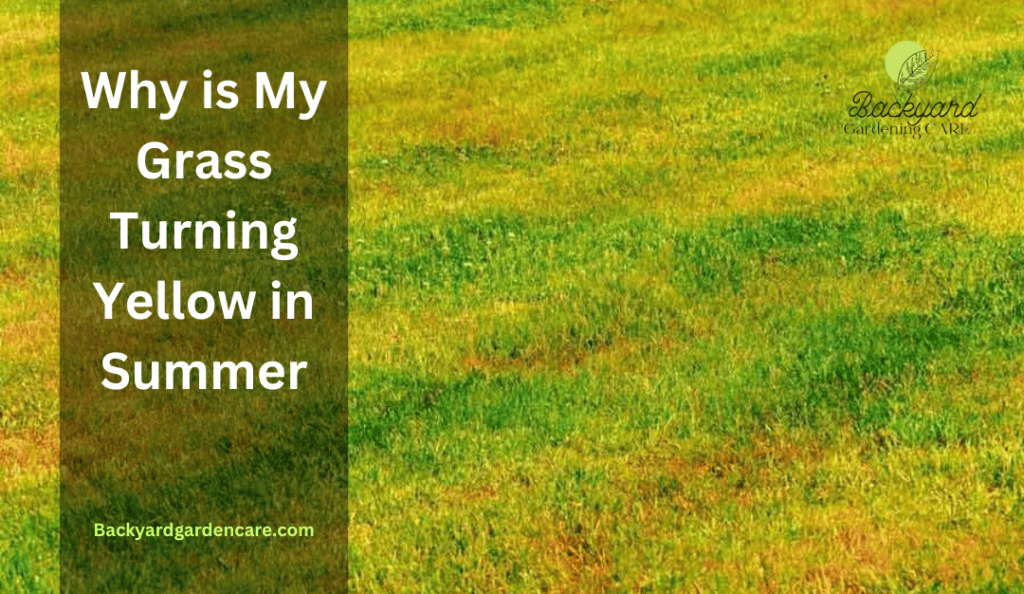
During the summer months, it is not uncommon for grass to turn yellow, which can be attributed to several factors. One of the main reasons for this is excessively hot weather.
When the temperature rises to extreme levels, it can cause the grass to become dehydrated and stressed. This dehydration leads to damage and discoloration, resulting in the yellowing of the grass. If you’re wondering what temperature kills grass seeds, it’s essential to consider that excessively high temperatures can also affect seed germination and overall grass growth.
Additionally, if certain areas of your lawn are exposed to full sun throughout the day, they are more susceptible to drying out and turning yellow. To combat the dryness and prevent your grass from turning yellow, there are a few steps you can take.
Firstly, it is important to water your lawn more frequently and deeply. This means providing thorough watering to ensure that the water reaches down to the roots of the grass.
It is advisable to water your lawn early in the morning if possible, as this allows the water to dry over the course of the day. It is best to avoid watering your lawn during the hottest parts of the day since this can cause the water to evaporate quickly.
In addition to watering, you may also consider reseeding your lawn in the fall to repair any significant damage caused by the yellowing. Fall is generally a good time for reseeding, as the cooler temperatures and increased moisture provide optimal conditions for new grass to establish itself.
Overall, yellowing grass in the summer is often a result of heat stress and dehydration. It is possible to maintain healthy, green grass throughout the summer months by watering more frequently and deeply and considering reseeding in the fall.
Yellow Spots Due to Various Diseases
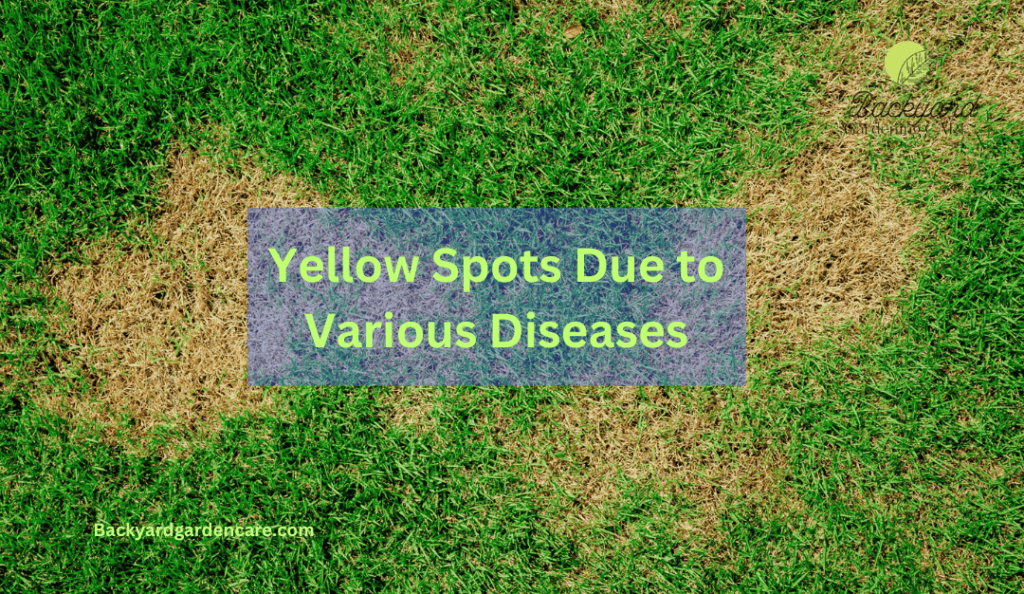
Your lawn is a beautiful and vital part of your home’s aesthetic appeal. However, sometimes your lawn can develop unsightly yellow spots due to various diseases commonly caused by fungi.
These fungal diseases are often affected by factors such as temperature, thatch, and moisture levels. Some of the most common fungal diseases that can lead to yellow spots on your lawn include fairy rings, snow mold, fusarium, and smut.
One of the key ways to prevent fungal diseases in your lawn is to ensure that it is properly dethatched and aerated. Thatch refers to the layer of dead grass and roots that can accumulate on the surface of your lawn.
When this layer becomes too thick, it creates a damp environment conducive to fungal growth. Regularly dethatching and aerating your lawn can help improve air circulation and reduce the risk of fungal diseases.
Another important factor to consider is the timing of your watering. It is recommended to water your lawn in the early morning hours. This allows the moisture to have sufficient time to evaporate throughout the day, reducing the chances of it sitting overnight and creating a damp environment for fungal growth.
Additionally, avoid overwatering your lawn, as excess moisture can contribute to developing fungal diseases. Proper lawn maintenance also involves regularly removing clippings, debris, and leaves.
These can act as a barrier, trapping moisture underneath and providing a favorable environment for fungal growth. By promptly raking up and removing these materials, you can help prevent the accumulation of moisture and minimize the risk of fungal diseases.
Taking these preventive measures can go a long way in ensuring the health and appearance of your lawn. Ultimately, yellow spots in the grass can be caused by various factors, including dog urine, fungal infections, soil issues, improper watering, lawn pests, chemical spills, and heat stress.
By understanding these causes, you can take effective measures to prevent and treat yellow spots, ensuring a vibrant and healthy lawn all year round. Remember to consult with professionals if you need further assistance diagnosing and treating lawn problems.
Preventing Yellow Spots in the Future.
Maintaining a lush and vibrant lawn requires regular care and attention. By following a few simple steps, you can prevent the formation of unsightly yellow patches on your lawn. Here are some key tips to keep in mind.
1. Fertilize – Regular fertilization is essential for the health and growth of your grass plants. Apply a high-quality fertilizer two to three times a year, following the instructions provided.
This will provide the necessary nutrients for your lawn to thrive and prevent yellowing. You should avoid applying extra fertilizer to your lawn because it will cause your grass turning yellow after fertilizing.
2. Water – Proper watering is crucial for maintaining a healthy lawn. Aim to water your lawn at least once a week, ensuring it receives around 4cm of water during the growing season. Deep watering encourages the development of strong and deep root systems, which helps prevent yellow patches.
3. Mow – Regular mowing plays a significant role in strengthening your grass plants. However, it is important to mow correctly to avoid damaging your lawn. Ensure that the blades of your mower are sharp to achieve clean cuts.
Mow the grass blades no more than a third of their length in one go. This allows your grass to recover quickly and avoids stress that can lead to yellowing.
4. Liming – Soil acidity can contribute to the formation of yellow patches and the growth of moss and weeds. Applying lime to your lawn can help neutralize acidity, creating a more favorable environment for your grass to thrive. Consult a professional or conduct a soil test to determine the amount of lime needed for your lawn.
5. Remove weeds – Weeds compete with your grass for nutrients and water, forming yellow patches. Regularly inspect your lawn and remove any weeds that you come across. Ensure weeds are controlled appropriately to prevent them from spreading.
By following these preventive measures and maintaining regular lawn care practices, you can enjoy a healthy and vibrant lawn all year round.
Conclusion.
Yellow spots in the grass can be treated with treatments by following lawn care methods. By identifying the underlying causes, such as overwatering, nutrient deficiencies, or pet urine, you can address these issues and restore the health and beauty of your lawn.
Furthermore, specialized treatments such as soil amendments, pet spot removers, or fungicides can help control and prevent yellow spots.
FAQs
Why is My New Grass Turning Yellow?
The yellowing of new grass can be due to various reasons. One common cause is overwatering, leading to root rot and nutrient deficiencies. Additionally, insufficient watering can also cause the grass to turn yellow.
Another factor could be inadequate sunlight. Improper soil pH levels or nutrient imbalances may also contribute to yellowing. Ensuring the grass receives the right amount of water, sunlight, and nutrients is important.
Is Yellow Grass Dead?
Yellow grass does not necessarily indicate that it is dead. It can be a sign of dormancy rather than complete death.
How Do I Fix Yellow Spots on My Lawn?
First, to fix these yellow spots, determine the problem’s cause. If overwatering is the issue, reduce the frequency and duration of watering. If under-watering is the culprit, increase the frequency and amount of water applied.
Applying a balanced fertilizer and ensuring proper watering practices can help address nutrient deficiencies. For lawn diseases, consult a professional or use appropriate fungicides. Additionally, aerating the lawn and overseeding can promote healthy growth and help fill the yellow spots.
What Nutrient Deficiency Causes Yellow Grass?
A nutrient deficiency that can cause yellow grass is a lack of nitrogen. Nitrogen is an essential nutrient for plants and is necessary for healthy growth and vibrant green color.
When grass does not receive enough nitrogen, it can appear pale yellow or straw-like. Iron deficiency is another nutrient deficiency that causes yellow grass.
Is Urea Good for Grass?
Yes, urea can be good for grass. Urea is a nitrogen-rich fertilizer that can provide essential nutrients to promote healthy growth and improve the overall appearance of grass. However, using urea properly and in moderation is important, as excessive use can lead to burning or damage to the grass.
Can Yellow Grass Turn Green Again?
Yes, yellow grass can turn green again under certain conditions. Yellow grass is often a sign of stress or damage, such as lack of water, nutrient deficiencies, disease, or excessive foot traffic. Addressing these underlying causes can help the grass recover and regain its green color.
Does Grass Turn Yellow With Too Much Water?
Yes, grass can turn yellow with too much water. Overwatering can lead to waterlogged soil, which prevents oxygen from reaching the grassroots.
This lack of oxygen can cause the roots to suffocate and die, resulting in yellowing of the grass. Additionally, excessive water can promote the growth of fungi and diseases that can also lead to yellowing.
Can Too Much Fertilizer Turns Grass Yellow?
Yes, excessive fertilizer can cause the grass to turn yellow. When too much fertilizer is applied, it can lead to an imbalance of nutrients in the soil, particularly an excess of nitrogen.
This can result in the grass leaves turning yellow or brown and may eventually die off.
Jack Ralph

hey, I’m Jack Ralph, a dedicated grass and lawn expert with years of experience creating beautiful outdoor spaces. I can help you achieve the lawn of your dreams, from seeding to mowing, turning your yard into a natural masterpiece.
Look no further—I’m the key to transforming your lawn dreams into reality! and here to help you achieve a lawn that’s not just a patch of grass, but a canvas of natural artistry.

